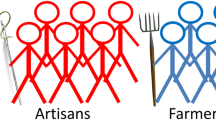Abstract
We consider a situation where society decides, through majority voting in a secret ballot, between the alternatives of ‘reform’ and ‘status quo’. Reform is assumed to create a minority of winners, while being efficient in the Kaldor–Hicks sense. We explore the consequences of allowing binding transfers between voters conditional on the chosen alternative. In particular, we establish conditions under which the winners wish to compensate all losers, thus leading to unanimity for reform, rather than compensating some losers to form a non-maximal majority. The analysis employs concepts from cooperative game theory.
Similar content being viewed by others
References
Angell A, Graham C (1995) Can social sector reform make adjustment sustainable and equitable? J Latin Am Stud 27:189–219
Aumann R (1987) Game theory. In: Eatwell J, Milgate M, Newman P (eds) The new Palgrave: a dictionary of economics. Macmillan Press, London and Basingstoke, pp 460–482
Axelrod R (1970) Conflict of interest. Markham, Chicago
Banks JS (2000) Buying supermajorities in finite legislatures. Am Polit Sci Rev 94:677–681
Baron DP (2001) Theories of strategic nonmarket participation: majority-rule and executive institutions. J Econ Manage Strategy 10:47–89
Baron DP, Ferejohn J (1989) Bargaining in legislatures. Am Polit Sci Rev 83:1181–1206
Brams SJ, Fishburn P (1995) When is size a liability? Bargaining power in minimal winning coalitions. J Theoret Polit 7:301–316
Brams SJ, Jones MA, Kilgour DM (2005) Forming stable coalitions: the process matters. Public Choice 125:67–94
Browne E (1993) Coalition theories: a logical and empirical critique. Sage, London
Claussen CA (2002) On the dynamic consistency of reform and compensation schemes. J Policy Reform 5:133–144
Dewatripont M, Roland G (1997) Transition as a process of large-scale institutional change. In: Kreps DM, Wallis KF (eds) Advances in economics and econometrics: theory and applications: 7th world congress vol 2. Econometric society monographs, no. 27. Cambridge University Press, Cambridge, UK, pp 240–278
Edwards S, Lederman D (2002) The political economy of unilateral trade liberalization: the case of Chile. In: Bhagwati J (ed) Going alone: the case for relaxed reciprocity in freeing trade. MIT Press, Cambridge, MA, pp 337–393
Fishburn P, Brams SJ (1996) Minimal winning coalitions in weighted-majority voting games. Soc Choice Welf 13:397–417
Greenberg J (1990) The theory of social situations. Cambridge University Press, Cambridge, UK
Groseclose T, Snyder JM (1996) Buying supermajorities. Am Polit Sci Rev 90:303–315
Groseclose T, Snyder JM (2000) Vote buying, supermajorities, and flooded coalitions. Am Polit Sci Rev 94:683–684
Grossman GM, Helpman E (2001) Special interest politics. MIT Press, Cambridge, MA
Haggard S, Webb S (1994) Voting for reform: democracy, political liberalization and economic adjustment. Oxford University Press, New York
Jain S, Mukand SW (2003) Redistributive promises and the adoption of economic reform. Am Econ Rev 93:256–264
Lau LJ, Qian Y, Roland G (2000) Reform without losers: an interpretation of China’s dual-track approach to transition. J Polit Econ 108:120–143
Riker WH (1962) The theory of political coalitions. Yale University Press, New Haven
Saint-Paul G (1993) On the political economy of labor market flexibility. In: Blanchard OJ, Fischer S (eds) NBER Macroeconomics Annual 1993. MIT Press, Cambridge, MA, pp 151–187
Volden C, Carrubba CJ (2004) The formation of oversized coalitions in parliamentary democracies. Am J Polit Sci 48:521–537
von Neumann J, Morgenstern O (1947) The theory of games and economic behavior. Princeton University Press, Princeton
Weyland K (1998) Swallowing the bitter pill: sources of popular support for neoliberal reform in Latin America. Comp Polit Stud 31:539–568
Author information
Authors and Affiliations
Corresponding author
Rights and permissions
About this article
Cite this article
Asheim, G.B., Claussen, C.A. & Nilssen, T. Majority voting leads to unanimity. Int J Game Theory 35, 91–110 (2006). https://doi.org/10.1007/s00182-006-0042-5
Revised:
Published:
Issue Date:
DOI: https://doi.org/10.1007/s00182-006-0042-5



